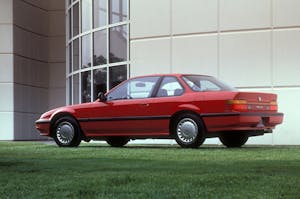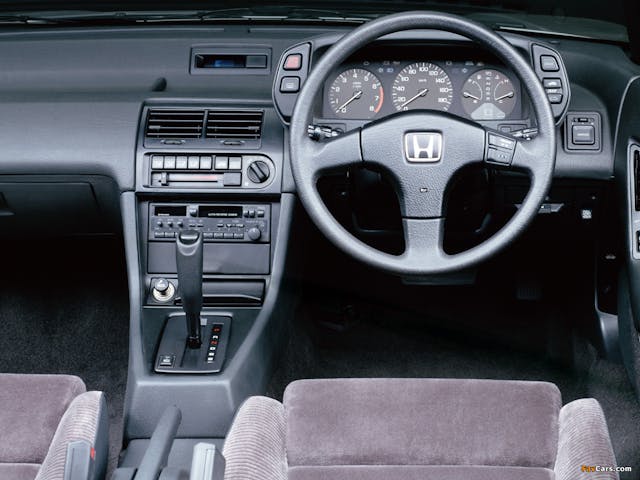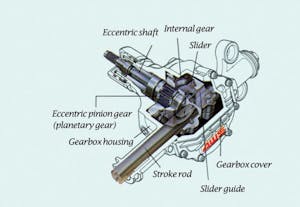Media | Articles
Four-wheel steering is having its moment (again)
Over the long life of the automobile, technologies have come and gone. While nobody is using in-dash record players or Liquid Tire Chain, other advancements, like steering with all four wheels, evolved and improved with the times. Depending on the application, it’s a technology that some enthusiasts specifically seek out, while others avoid it or take pains to disable such systems. Once purely practical, four-wheel steering is a largely now a performance feature to improve handling on sports cars. Let’s dig into how it works, how it came to be, and why it’s made a comeback in recent years.
Standardization is a fact of global industrial production on the scale of vehicle manufacturing, but there’s a good reason cars steer using the front wheels. For one, rear-wheels steering alone makes for tricking handling—just ask anyone who has tried to drive a forklift in a straight line at any speed. On top of that, steering with the front wheels is safer for high-speed driving and more efficient, given that the steering wheel is also at the front of the vehicle.

So how did we end up with cars like the Nissan Skyline and Honda Prelude that add angle to the rear tires? Rear steering was used for some farm equipment in the pre-automotive era, but once the horse and buggy became the default means of conveyance by road, front wheels needed to follow the directional choice made by the pulling animal. Those horse drawn-carriages slowly became self-propelled with the adoption of steam, electric, and liquid fuel engines, and kept their front steering layout. If early automotive experimenters and engineers attempted to make cars steer with four wheels in any meaningful way, it never caught on.
As the years pressed on, automakers’ ability to control more of the minute movements of suspensions improved. The use of rubber bushings in rear suspension assembly helped isolate road noise from the car’s occupants, but it caused the toe angle of the rear wheels to change if the driver was aggressive with throttle inputs. If the system had the right flex in the right places it worked as intended, angling the rear tires inward, but some attempts did the opposite, yielding tough handling characteristics. This phenomenon is known as compliance steer, and it could be called a precursor to four-wheel steering. In the end, harnessing the deflection of the rear suspension components was how engineers developed the first computer-controlled four-wheel steering systems.

Nissan came out with the R31-generation Skyline in 1985. One of its most impressive features was a pair of hydraulic pistons in the rear suspension that selectively compressed the bushings in the car’s rear subframe, effectively creating compliance steering calculated by a computer. When the driver turned the steering wheel, the computer determined the current speed and added angle as necessary to the rear wheels. This system gave the rear trailing arms about half a degree of angle, which doesn’t sound like a lot, but it is enough to help with high-speed stability and cornering. It was a simple system that worked, and it proved four-wheel steering was worth spending development dollars to improve and study. Automakers bombarded the patent office with ideas in the late 1980s. It was Honda, however, that took the idea to the next level.
Marketplace
Buy and sell classics with confidence

The 1988 Honda Prelude featured a fully mechanical system that used a slider on the rear tie rods to move the angle of the rear wheels. A small gearbox connected to the front steering system by way of a shaft, and depending on the amount of front wheel steering angle, the rear wheels angled the same direction or opposite the fronts. The cutoff was 240 degrees, at which point the rear wheels would counter steer—which effectively shortens the wheelbase—to aid in tight maneuvering. (Parking, for example.) Up to that 240-degree angle, the rears wheels used the same angle as the fronts (effectively stretching the wheelbase) to stabilize the car at speed. Honda’s hope was that it would to make the Prelude’s handling feel more intuitive to the driver.

Nissan, Mazda, Mitsubishi, and even Chevrolet developed similar systems for a variety of applications spanning compact cars to long pickups. While Honda stuck with a mechanical system, other manufacturers built their systems with hydraulic and electric assist, which could give more angle to the rear wheels and accounted for more “if/then” scenarios than the Honda design, which functioned purely on the 240-degree steering angle cutoff. For instance, Chevrolet’s Quadrasteer gave the rear tires a maximum of 15 degrees of angle, but if trailer mode was engaged, it would self-limit at 12 degrees.
Despite the ambitions for such systems, the benefits on paper did not manifest in real life with the experience consumers had on the road. Especially in the U.S., Chevrolet suffered slow sales of Quadrasteer vehicles and responded by dropping the price from $5600 at introduction to just $1000 in 2005, the final year it was offered as an option.
Many four-wheel steering systems faded from popularity by the early 2000s, but the technology has made a comeback with modern machines such as the Porsche 911, Lexus LC 500, Mercedes-AMG GT R and GT C, Lamborghini Aventador, Ferrari 812 Superfast, Ferrari GTC4Lusso, and others. Some version of four-wheel steering is even offered on mid- and full-size sedans from Acura, Audi, BMW, and Lexus. Not only has the technology evolved, but at the price point these (mostly) high-end cars inhabit, the cost and complexity of four-wheel steering is more palatable.
As Acura demonstrated on the 2014 RLX, modern variations of four-wheel steering advance previous developments to even higher levels by equipping each rear wheel with its own electromechanical adjustment that controls the toe angle of the wheels independently, which is a big departure from prior tie-rod based designs. This allows a pre-programmed computer to accurately change the angle, based on vehicle speed, steering angle, and road conditions. The Porsche 911 joined the RLX and the BMW 5 Series in the rear-steer club when Porsche rolled out four-wheel steering on the 911 Turbo, Turbo S and GT3 back in 2013.

With over a century of automobile production, no idea is new. Four-wheel-steering is proof of how an idea that was once impractical can be prime for a resurgence as technology and consumer demands change. For example, a self-driving car would be a perfect application for a system which could add even more angle to the rear wheels, and the use of hub motors on electric vehicles remove the complexity of sensitive constant-velocity joints. At this point, it is likely we have not seen the last of four-wheel-steering—we’re looking forward to the direction it takes us in next.





from a theoretical point of vue, 4 wheel brakes brake better than two wheel brakes, AWD/4WD accelerates better, 4 wheel steering should corner better too, right?
higher lateral G’s? keeping the rear inside wheel on the road instead of in the air? better stability? for maneuvers, having rear wheels follow the same tracks as the front ones would make everything easier too?
there are probably gains from not having extreme angles in the front steering too